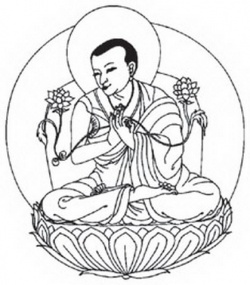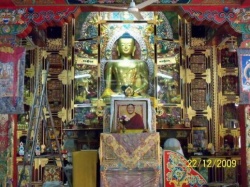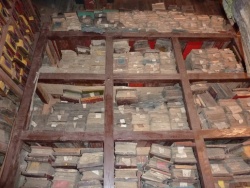Bari Lotsawa
Bari Lotsawa (བ་རི་ལོ་ཙཱ་, Wyl. ba ri lo tsA) aka Rinchen Drak (rin chen grags) (1040-1111) — the second throne holder of Sakya school (Tib. Sakya Trizin). At the age of 63, he retained the seat of Sakya for a period of eight years (1102-1110). He is one of the main lineage figures in the transmission and translation of the White Tara practice and tantras that originate from the Indian master Vagishvarakirti.
Further Reading
- The Blue Annals (Trad. Roerich, G.N.), Delhi: Motilal Barnasidass, 1996, p.1021-1024.
See Also
External Links
Source
Bari Lotsawa Rinchen Drag (1103-1111) a translator from Kham acted as the second Sakya Tridzin and tutor to the young Kunga Nyingpo.
Bari Lotsawa (བ་རི་ལོ་ཙཱ་, Wyl. ba ri lo tsA) aka Rinchen Drak (rin chen grags) (1040-1111) — the second throne holder of Sakya school (Tib. Sakya Trizin). At the age of 63, he retained the seat of Sakya for a period of eight years (1102-1110). He is one of the main lineage figures in the transmission and translation of the White Tara practice and tantras that originate from the Indian master Vagishvarakirti.
1 An Indestrucable Legacy: The Life of Bari Lotsawa by Lama Jampa Thaye One of the greatest and most influential masters in the history of Buddhism in Tibet was Bari Lotsawa (1040 – 1111), the second throne holder Sakya Trizin of the Sakya tradition. His contribution, both as a translator (Lotsawa) and tantric master, helped to ensure the continuity of the
precious vajrayana teachings in Tibet. Perhaps his outstanding legacy has been the famous collection of deity meditations known as ‘The One Hundred Sadhanas of Bari’ (Bari Gyatsa) which has been preserved into modern times where it still forms a vital part of contemporary vajrayana practice.
Bari Lotsawa (‘the translator of Bari’) was born in Kham in 1040 AD. His personal name was Rinchen Drakpa. Having studied the dharma in his childhood, by the age of fifteen Bari Lotsawa had decided to travel to India. His ambition was to train as a translator in the footsteps of such luminaries of the ‘new translation era’ as Rinchen Zangpo and Drokmi Lotsawa. On the way Bari met Atisha at Nyethang shortly before the latter’s death. During this meeting Bari was advised to
study in India with Dorje Denpa, a great master of vajrayana and disciple of such siddhas as Jetari. Bari Lotsawa made two extensive visits to India, where he received innumerable initiations and teachings from Dorje Denpa and other
masters. He experienced a number of visions of his yidams Chenrezi and Tara at whose prompting he performed acts of considerable kindness such as ransoming those unjustly imprisoned. Subsequently in Ngari, Western Tibet, he received teachings on the five principal works of Nagarjuna from the scholar Parahita. Having achieved realisation through intensive study and practice, Bari Lotsawa gathered many disciples throughout Tibet.
In 1103, following the death of Khon Konchok Gyalpo, the founder of Sakya, some of the latter’s disciples invited Bari Lotsawa to Sakya. Their plan was for him to act as tutor for Konchok Gyalpo’s son, Kunga Nyingpo, who was then only 11 years old. It is said that it was only after sorcery was performed towards him that Bari Lotsawa acceded to this request. Bari Lotsawa
took charge of Sachen Kunga 2 Nyingpo’s training and acted as the ‘throne holder’, or head of Sakya, until his own death in 1111 at which time he was succeeded by Sachen himself. During these years Bari Lotsawa bestowed various mahayana teachings
upon his young disciple but most importantly transmitted a host of tantric teachings to him. These included The One Hundred Sadhanas, a collection of teachings that he had received in India from Dorje Denpa and other panditas, the Guhyasamaja tantra, the Yamantaka tantra and the three tantras of Hevajra.
One of the four sources of Mahakala Gonpo Gur in the Sakya tradition derives from Bari Lotsawa’s bestowal of the relevant initiation upon Sachen Kunga Nyingpo. Furthermore, four of the famous esoteric teachings, known as The Thirteen Golden Dharmas, viz. Kurukulla, Kamaraja, Simhamukha and Black Manjushri, were transmitted to Sachen by Bari Lotsawa.
‘The Hundred Sadhanas of Bari’ in particular became one of the most famous cycles of vajrayana practices in the Sakya tradition and attracted many adherents from other schools. It is an incomparable repository of deity meditations drawn from all four sets of tantras though possessing a particular emphasis on Kriya and Charya tantras.
Thus it contains many techniques for acquisition of both mundane and transcendental accomplishment. Within the collection are many sadhanas of deities bestowing wisdom such as Manjushri and Prajnaparamita, and numerous sadhanas of compassion bestowing deities such as Chenrezik, longevity bestowing deities as represented by White Tara and
Namgyalma, while wealth bestowing deities include Dzambala and Vasudhara. There are Guhyasamaja tantra, the Yamantaka a number of sadhanas of magnetising deities such as Kurukulla found in the collection as well as [[wrathful
deities]] like Yamari and Hayagriva. Deities bestowing fearlessness such as Marichi and the ‘five protection goddesses’ are also contained in the hundred sadhanas as well as deities providing remedial help for particular disturbances such as Parnashavari and Achala. ‘
The Hundred Sadhanas of Bari’ has been transmitted in an unbroken lineage within the Sakya school down to this present
day. At the end of the 19th century Jamgon Loter Wangpo included the collection in his monumental compendium The Collection of All Sadhanas (Drubthap Kundu). Loter Wangpo bestowed the Bari sadhanas and the rest of the compendium upon Dakshul Thinley Rinchen, the then Sakya Trizin, and grandfather of His Holiness, the present Sakya Trizin. Thinley Rinchen (after
whom our centre is named) then bestowed them upon his sister Pema Thinley Dudul Wangmo, who in turn transmitted them to Zimok Tulku from Nalendra monastery, the headquarters of the Tsharpa subsect in central Tibet. Subsequently Zimok Tulku transmitted
The One Hundred Sadhanas to H.E. Chogye Trichen, the present head of the Tsarpa school. His Eminence bestowed them together with the other part of Loter Wangpo's ‘Collection of Sadhanas’ upon Karma Thinley Rinpoche in Lumbini. Subsequently Rinpoche transmitted the Bari collection to me. © Lama Jampa Thaye 2003.


